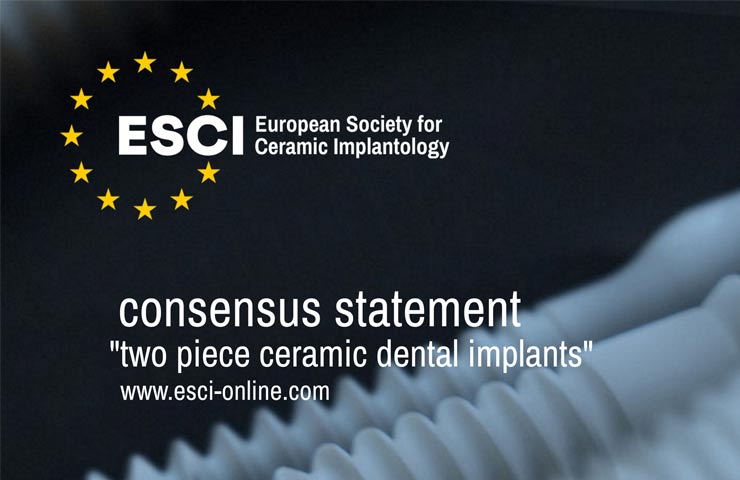The development of high-performance ceramics—such as zirconium dioxide (zirconia, ZrO2)—has created new, metal-free treatment options for both patients and practitioners in various fields, including dental implantology. Owing to its superior biomechanical and biocompatible properties, zirconia has prevailed over other oxide ceramics and has been used in dentistry for about 25 years. Thus, ceramic implants made of zirconia represent a significant complement to titanium implants and thus an expansion of the treatment spectrum in dental implantology. Fortunately, different consensus papers from various professional societies have confirmed that one-piece ceramic implants are sufficiently documented in the scientific literature and regard this as the main reason why one-piece ceramic implants have found their way into clinical practice. In this context, for example, the medical necessity of ceramic implants has already been accepted by the cost bearers in Germany as a central service requirement for cost coverage.
However, based on scientific statements and recommendations of professional associations, two-piece ceramic implants are still often denied this recognition with the argument that there is a lack of scientific evidence and consequently a lack of medical necessity for this type of implant. The European Society for Ceramic Implantology (ESCI), a scientific and independent medical society, is of the opinion that, when determining the medical necessity of two-piece ceramic implants, the assessments of specialist and topic-specific professional societies should also be taken into account in particular. Furthermore, the ESCI is of the opinion that a well-founded and fundamental consensus statement by a medical society on the clinical reliability of two-piece zirconia implants is required in view of the literature available to date on this type of implant. Against this background, the ESCI has taken on the task of compiling an official evidence-based statement on the clinical use of two-piece ceramic implants. This statement was prepared, formulated and consensually adopted by the Scientific Advisory Board and the Board of Directors of the ESCI, which consists of renowned scientists and experienced experts in the field of ceramic implantology: Prof. André Chen, Prof. Jérôme Chevalier, Prof. Jens Fischer, Prof. Michael Gahlert, Prof. Ralf Kohal, Dr Frank Maier, Prof. Mutlu Özcan, Prof. Michael Payer, Prof. Corrado Piconi, Dr Stefan Röhling, Dr Jens Tartsch and Prof. Werner Zechner.
For this statement, the currently available literature was reviewed and clinical experience was taken into account. It objectively and independently reflects the state of evidence on two-piece ceramic implants, the general background to ceramic implants is presented as an introduction and the current scientific assessment of the ESCI on two-piece ceramic implants is given. A final legal assessment is not within the realm of responsibility of the ESCI. The key points of the statement are as follows:
– The two-piece zirconia implant concept offers advantages over the one-piece concept regarding prosthetic flexibility and clinical indications.
– Two-piece zirconia implants can resist clinical masticatory forces.
– Fracture resistance and mechanical stability of two-piece zirconia implants may vary as a function of different manufacturing processes, material properties, implant geometries and prosthetic connection concepts.
– One- and two-piece zirconia implants demonstrate the same level of osseointegration and biological integrity.
– For clinical success, each manufacturer’s guidelines regarding strict application for the specified clinical indications should be followed for the respective two-piece zirconia implant system.
– The ESCI Scientific Advisory Board states, based on the conclusions above, that the two-piece zirconia implant concept is appropriate for clinical application.
For more information on the recently released consensus statement and the full statement, visit the ESCI website at https://esci-online.com/en/statements
